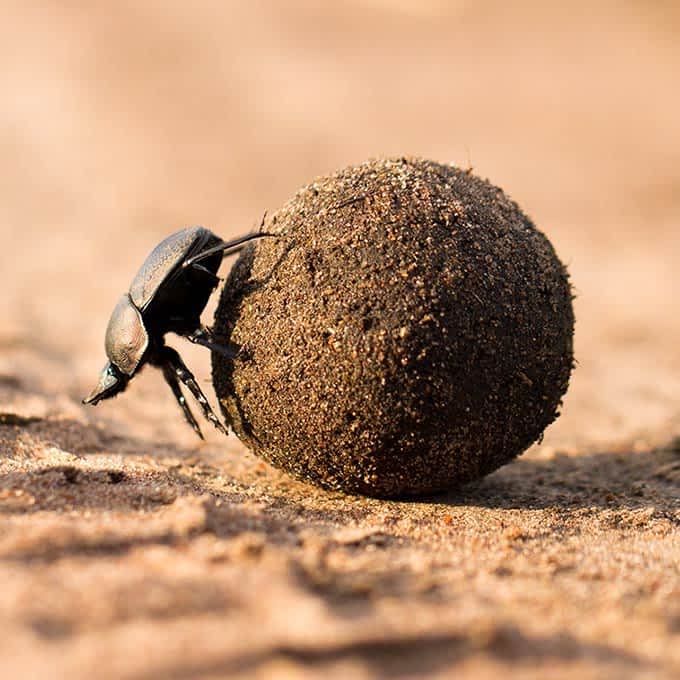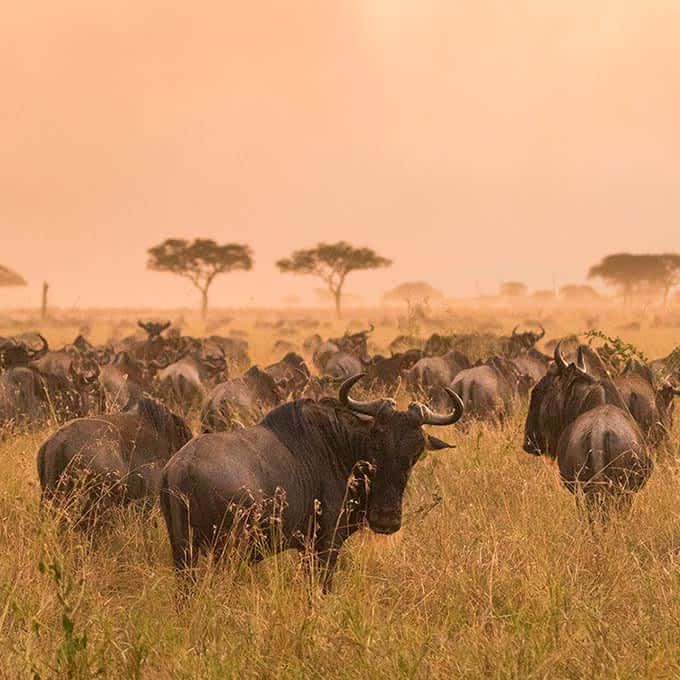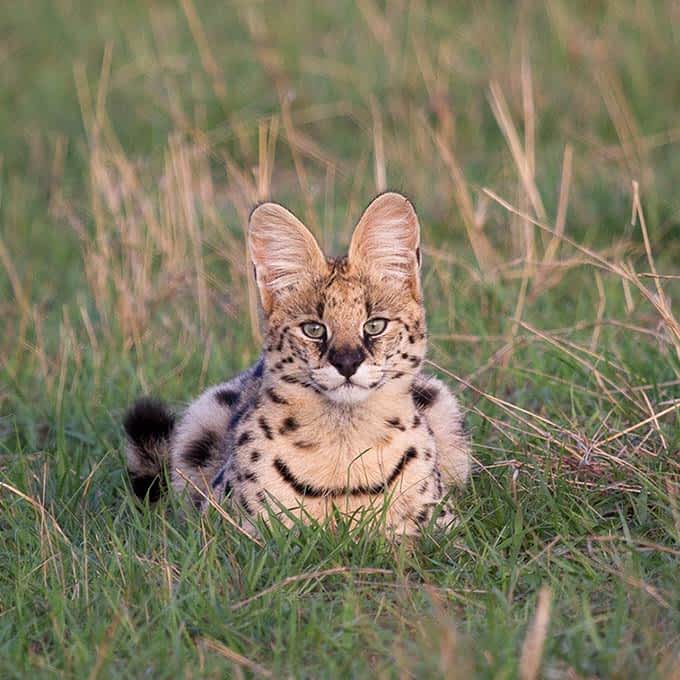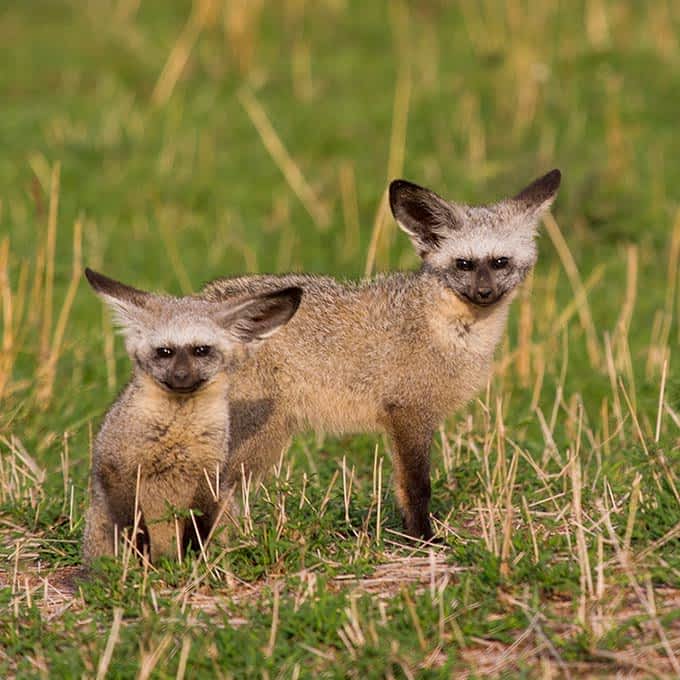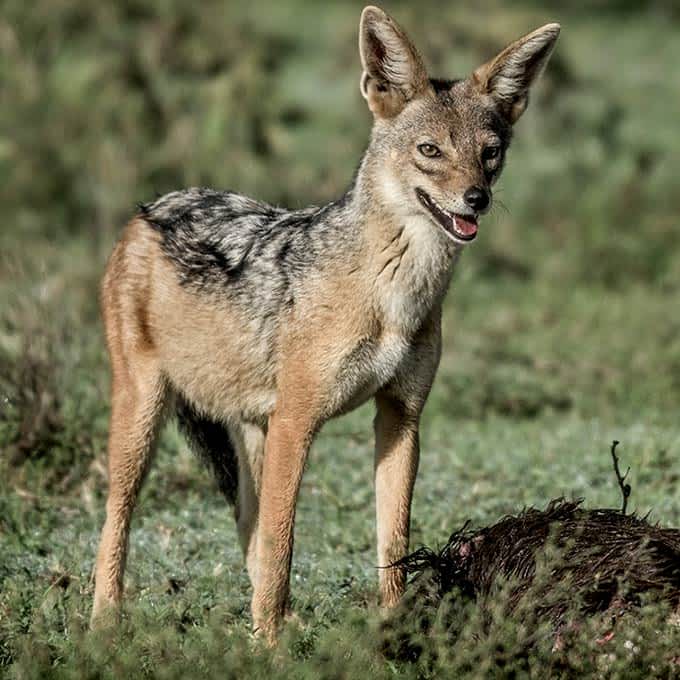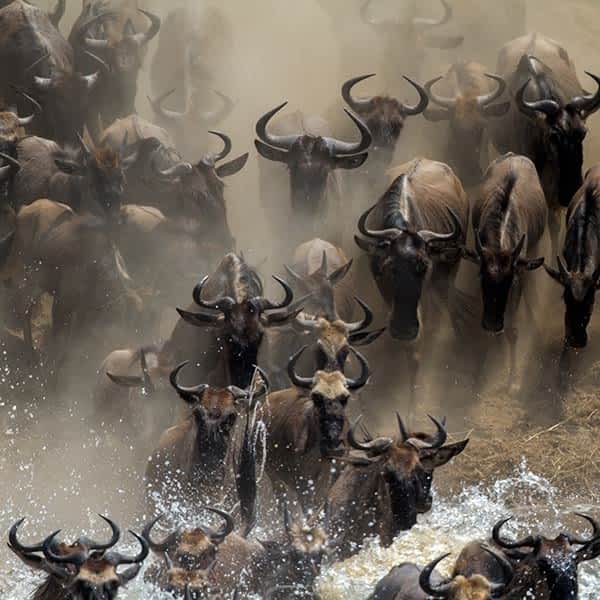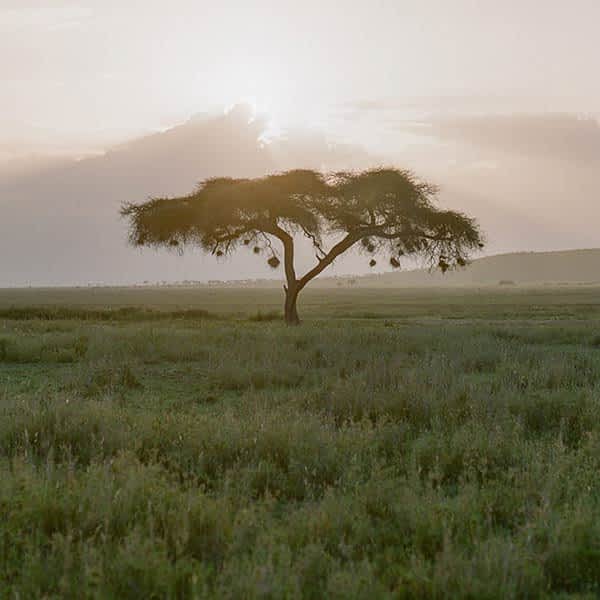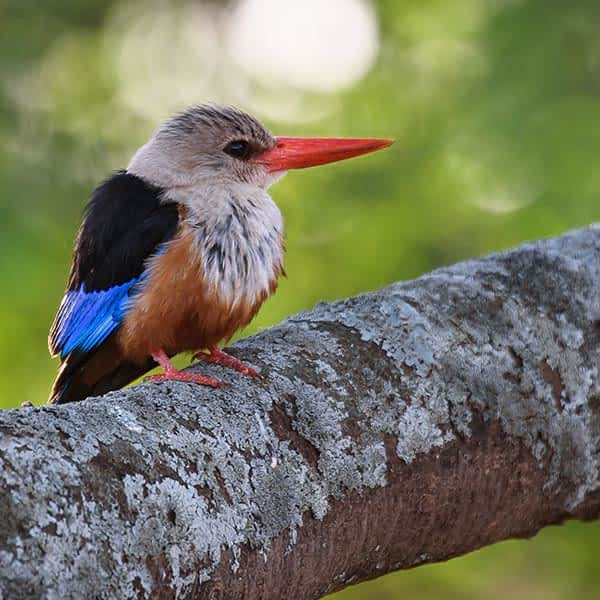Wildlife on the plains
The Serengeti sustains not just the largest herds of migrating ungulates but also the greatest concentrations of predators in the world. Estimates put wildebeest at between 1.3 and 1.7 million, zebra at 200,000 and Thomson's and Grant's gazelle at around 500,000. These herds support around 7,500 hyena, up to about 4,000 lions and 500 to 600 cheetahs.
Interminable distance migrants comprise wildebeest, zebra, Thompson's gazelle and eland. Likewise, Grant's gazelle also moves some distance, however little is known about where they go. The migrants are supported by the plains in the wet season, but only a few Grant's and Thompson's gazelle and ostrich live there in the dry season. Oryx occur on the Salai plains, but they are rare and their numbers are unknown.
Wildlife in the woodlands
The woodlands have several resident species of animals. Topi occur throughout the woodlands, but they form large herds on the wetter plains of the Western corridor and the Serengeti Mara area and are non existent in the east. In contrast to their close relative, the kongoni, prefer the eastern woodlands and long grass plains. Impala, steinbuck, dik dik, elephant and buffalo are active throughout the woodlands and avoid the plains. At the turn of the millennium, elephants were scarce in the Serengeti, but an aerial survey undertaken in 2014 counted over 8,000 individuals in the Serengeti-Mara ecosystem, as compared with the 1986 tally of around 2,000. Some sources attribute this increase to greater persecution outside protected areas, but whatever the cause, elephants are noticeably more common than they were even ten years earlier, with the greatest concentrations to be seen in the north. The same survey showed that the buffalo population of the Serengeti possibly stands at around 50,000 individuals.
Giraffe also occur throughout the woodlands, but you may see them strolling across the plains to the Gol Mountains and the Ndutu woodlands. Waterbuck are confined to the bigger rivers with grassland. Bahor reedbuck may also be found along rivers. They spread through the long grass plains in the rainy season bur are most active at night. Warthog are widespread but scarce in the woodlands and just a few on the plains. Oribi are prevalent in the northwest, with a few found northeast near Klein's Camp. Grey duiker are also found in the northwest with a few in the hills elsewhere. The majestic Roan antelope occurs in two localities, the northwest (Ikorongo, Lamai and Mara Triangle in Kenya), and in the south near Maswa. The far south of Maswa also sustains greater kudu.
Wildife in riverine forests
If you are in the riverine forests, keep in mind to look up and down. The diversity and abundance of insects and plants makes the forest a fantastic place to see animals and birds. There are insects and seed eaters such as banded mongoose, shrews and the large marsh mongoose. Plant eaters such as duiker and bushbuck hide in the thick cover. In the canopy above, you might see tree hyrax which may seem like huge rodents; in fact, they are more closely related to elephants! Black-and-white colobus monkeys can be seen in the woodlands along the Grumeti River. We find both olive baboons and vervet monkeys through the woodlands close to water; and baboons are especially abundant along the western corridor.
In the rivers themselves, shaded by the trees of the forest, rest the giant crocodiles of the Grumeti and Mara rivers. Hippos spend the days submerged in the river or in their greenish pools throughout the dry season. These two species live without a problem in the same confined pools.
Serengeti predators
Of the larger carnivores, cheetah, hyena and lion are found in almost all Serengeti environments. Serengeti National Park rarely disappoints when it concerns large cats. The Tanzanian side of the Serengeti ecosystem supports about 3000 to 4000 individuals of lion, most likely the largest population left in Africa, and hundreds of resident lions wander the plains around Seronera, and the Simba, Moru and Gol koppies close to the main Ngorongoro road. Here, it is not unusual to see two or three prides in the course of a single game drive. We frequently see lions lying low in the grass or basking on rocks, though many Serengeti prides are increasingly given to languishing in the trees on scorching days.
Leopard numbers are unknown, because of their secrecy and elusiveness. However, they are common in the Serengeti, and are often seen in the Seronera Valley. The estimated leopard population stands around a 1000 individuals. Cheetahs are frequently sighted as well: the park's estimated population of 500 to 600 individuals is densest in the open grasslands around Seronera and further east toward Ndutu.
Of the other predators that can be seen in Serengeti National Park, spotted hyenas are very common, perhaps more so than lions. Hyena form sizeable groups on open areas like the plains, but are solitary in much of the woodlands. Golden jackals and bat-eared foxes appear to be the most abundant canid species on the plains around Seronera, while black-backed jackals are fairly common for the thicker vegetation towards Lobo.
Driving at dusk or dawn, you stand the best chance of seeing night-time predators such as civet, African wildcat, and serval. A true rarity among the predators is the African wild dog (or painted dog), which was common until the 1970s; but unfortunately disease wiped out the entire population from the park in 1992. Fortunately, wild dogs are very mobile and wide-ranging animals, some travelling groups have been seen on the eastern plains and in recent years wild dog populations have been re-establishing to the northeast of the park in Loliondo. Several other introductions from elsewhere in Tanzania have taken place, and the Serengeti’s wild dog population is estimated to be as high as 250 individuals.
Reptiles, amphibians & fish
Serengeti National Park contains a vast variety and number of animals that creep and crawl. Most of these lizards, skinks, and serpents feed on the abundant insects and rodents in the grass while others specialize on birds eggs. Pythons can even devour animals as large as gazelles. Some crawlers are herbivores themselves, such as the leopard tortoise. Not all crawlers are small: monitor lizard lives in reeds and bushes and can grow to 1.5 meters long. The master of all crawlers, at over 800 kilogram and sometimes over five meters long, is the massive freshwater crocodile of Serengeti,. These ancient creatures can live for over a hundred years and will happily eat a whole wildebeest for supper.
The fish in Serengeti National Park are adapted to live in low oxygen muddy conditions and sometimes survive without water altogether. A helpful feature during the dry season. The catfish of the Mara and Grumeti Rivers sometimes pull themselves through the mud from pool to pool and can weigh up to 20 kilograms. Others, such as the lung fish, bury themselves completely in dry season, living in a cocoon beneath the dried cracked mud. Some smaller fish live to use their entire lifespan in the few months during the rains. As the pools dry they breed and lay their eggs in the mud. The eggs miraculously survive the hot dry winds of August and September, hatching into the next generation when it rains once again in December.
Frogs surveys have identified some 20 different species, many of these live in the trees and grasslands and in ponds and watering holes. The night sounds of the wet season are filled with the chorusing of frogs intent on making themselves heard above the background symphony of crickets and cicadas. This is the soundtrack of the African bush in wet season.
Insects
The first thing that many Serengeti National Park travellers notice is the apparent low numbers of insects. In fact, while the numbers of stinging insects is much lower compared to North America or Europe, the diversity of insects is much higher. Insect diversity abounds in Serengeti National Park from ants, beetles, weevils, and termites on the forest floor, to clouds of flies, wasps, and bees, to high flying swallow-tailed butterflies and giant rhinoceros beetles. Five of the more common insect groups and ones crucial for the ecology of the park are dung beetles, grasshoppers, termites, butterflies and ants.
Dung beetles
Beetles are the most diverse and successful group of animals on planet earth, with over 400,000 (!) known species. In the Serengeti over 100 different species of dung beetles are identified in just a small area of the plains. Each of these species specializing in a distinct dung type in different seasons. Without dung beetles, the Serengeti would become uninhabitable. These amazing creatures roll away and bury up to 75 percent of all dung dropped in the Serengeti, which amounts to several hundred tons per day. Their carefully crafted dung balls are buried and become home for beetle larvae which eat the leftover nutrients inside, leaving behind a hollow ball of earth. When soil researchers dug pits on the Serengeti plains, they found that 15 to 20% of the soil comprised buried dung balls. The colossal amount of dung and soil moved by dung beetles serves to fertilize and loosen the soil and plays a major role in maintaining the productivity of the entire Serengeti ecosystem.
Grasshopers
Grasshoppers are a diverse group of insects. Their physical shape and color changes as they grow, making the different species challenging to identify. Although eat fresh green grasses, some eat flowers, seeds and some are even predatory on other grasshoppers and tiny insects. Estimates accounting for the population size suggest that at certain times of the year grasshoppers eat more grass than any other group of animals in Serengeti National Park, including all wildebeest. Grasshoppers diversity in Serengeti is very high, researchers have identified over 60 species in just a few collection points. After the seasonal rains, the grasshopper numbers increase and draw enormous flocks of migratory birds to the Serengeti feasting on them.
Termites
Termites play a critical role in turning over nutrients in the Serengeti. Most termite species are night creatures, harvesting dead wood and grass. They use dead plant material to support fungus forms in underground chambers which they cultivate and eat. The soil used to build these chambers is mixed with saliva and used to build their distinctive mounds. Some termite mounds are up to 3 meters high with turret like chimneys. The shafts of the mounts provide homes for a variety of animals, such as snakes, mongoose and mice. Cheetah, lion, and wildebeest often stand on top of termite mounds using them to survey the area. On the flat plains, even a rise of just one meter gives an impressive view and is well worth the trouble to find food.
Butterflies and moths
Flying low over the grass or flitting from branch to branch in the woodlands, butterflies feed on nectar from flowers, thus fulfilling their function as pollinators. A sizeable group of animals feed on butterflies and moths, and as a result they have developed impressive tactics against being eaten. These include camouflage colouring, hiding, radar detection, toxic hairs, and large 'eye’ patterns on their wings which they flash to scare predators.
Ants
Biting red ants are the most noticeable of ants in Serengeti National Park. Biting red ants live in massive colonies. Unlike most ants, they do not have a permanent home. These ants rather hide in hollow tree trunks or underground holes during the day, but at night become voraciously marching predators. Enormous armies of ants have been known to push lions off a kill, consuming what is left. However, typically they go easier targets such insects, nesting birds, rodents, lizards and geckos. During the rainy season you can occasionally see highways of red ants crossing the road in the early morning as they return from their nightly escapades.
Why does the Serengeti have so many animals?
The Serengeti is unique because it is a transition area. There is a distinct changeover from the rich flat soils in the southern plains to the -much poorer- hilly soils in the north. Because of a rainfall gradient, the south receives much less rain than other locations. The Serengeti is also home to pockets of leftover riverine forests, the result of the landscape once being covered by dense lowland forests. Combined, this results in a diversity of different vegetation types and habitats across Serengeti National Park. It is precisely this diversity (and their dynamics) that supports the many different species we see today.
Further reading

